Following on from my last post, on coq
au vin, I’m sure you’ll have been waiting all a-tremble to find out what we
did with the leftovers. No? Oh…
Well maybe you should have been, because of
course the real glory
of chicken lies in the leftovers.
Lovely as a freshly roast
chicken is, many would argue - and I’d be hard pressed to say they were
wrong – that its flesh is even better cold the next day. Even if you don’t subscribe wholly to
that school of thought, what kind of person would you be if you weren’t even
slightly disappointed should a roast chicken not yield up enough pickings from
it’s carcass for a sandwich the next day?
Not my kind of person, that’s for sure. But even if you
were that kind of person then you couldn’t deny that the carcass itself,
converted into a rich, brothy stock, and thence into soups, risottos
and greatly enhanced sauces, prolongs the culinary life of the single bird you
started with at Sunday lunchtime, say, well into the middle of the week, if not
beyond.
Even leftover coq au vin (which was my
starting point from my last post), which you might be tempted to simply reheat
the next day, and I couldn’t blame you, is also easily adaptable into a
different meal entirely – and that’s the coq (along with its vin) itself I’m
referring to, not stock derived from its bones. And yes – I do pick the bones off the plates at the end of
the meal and use them for stock.
I’m not proud. And even if
you, or your guests have gnawed and sucked at those bones, I really don’t think
we have to worry about that, after all the process of being turned into stock
involves those bones being boiled for hours. Probably not quite the done thing in a commercial kitchen (or
strictly legal, what with health & safety going mad and all that…), but
perfectly fine at home. More than
fine, I’d say, more like an obligation, on grounds of thrift, consumer ethics
and crimes against flavour (and the waste thereof).
Still, between the coq au vin and the stock came the next
day’s dinner, for which I stripped the remaining meat from the bones (and set
those aside with the plate scrapings) then added the now boneless and shredded
coq au vin to a pan with some sliced chorizo piccante and a handful of cherry
tomatoes, halved and fried till just starting to soften, then added a sprinkling
of green olives (you can pit them yourself or just chuck them in whole with
appropriate warnings to your fellow diners – but don’t buy them ready pitted,
they’re really not the same. To
the extent that I’m afraid they don’t really count as olives, not in my book). Served as a sauce for a bowl of
pasta, in this case, gnocchi,
this made a very quick, thoroughly delicious and entirely different meal from
the night before.
More recently, in the current spell of
summery weather, I roasted
a chicken. I’ve blogged on roasting
before, several times so I won’t risk boring you all re-covering old ground,
but while on the broader subject of leftover chicken it would be just perverse
not to mention it at all. Or to
point out that it’s not just chicken sandwiches that you can do with cold roast
chicken, good though a chicken sarnie can definitely be. First use made of the leftovers of this
particular chicken was a simple, delicious and really rather attractive warm
chicken and potato salad.
I just boiled a portion each of new
potatoes, finely dicing and frying some smoked streaky bacon while they
cooked. Once drained and while
still hot I dressed the potatoes in olive oil and the juice and zest of half a
lemon, a pinch of salt and plenty of black pepper. Then I stirred through the cold chicken shredded from the
roast bird’s carcass, along with a handful of capers. Then it was simply a case of combining the warm potatoes,
chicken and bacon with a simple salad of chicory and red onion, with torn
fennel and celery leaves and serving it up.








